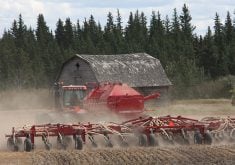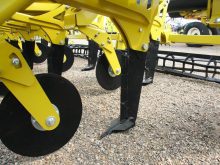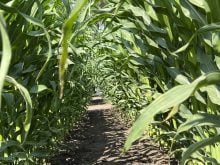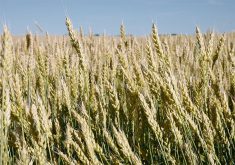The ideal time to seed winter cereals in the Prairies is between the end of August and the middle of September
An early start to harvest in some parts of the Prairies has advantages.
It gives farmers more choice of fields to plant winter cereals and more time to do it.
“Usually (time) that’s the biggest thing,” Alex Griffiths, Ducks Unlimited Canada’s Manitoba agronomist said in an interview Aug. 25. “You’re busy harvesting and don’t want to hop out of the combine to get into the air seeder… but if you have stubble options that are available to you it looks pretty attractive.”
Read Also

Crop quality looks good this year across Prairies
Crop quality looks real good this year, with the exception of durum.
Griffiths has received more calls so far this fall than in any of the four previous years DU Canada has offered its $20 an acre incentive to winter wheat growers.
The program pays new and expanding winter wheat growers $20 acre up to 250 acres or a maximum of $5,000, but they have to be in certain parts of Manitoba, Saskatchewan and Alberta.
More information is available at https://ag.ducks.ca.
Farmers who have grown winter wheat before but haven’t been part of the program are eligible, as are farmers who have been in the program but are increasing their winter wheat acres.
Participants also get a free soil test for fields intended for winter wheat.
Once an agreement between the farmer and DU Canada is signed, it’s a simple process, Griffiths said.
“You can seed it on any stubble, you can take it off for seed or feed depending on what you’re looking for and if it doesn’t make it through the winter, we don’t ask for any of the funding to be given back we just ask that you try growing it again in the future,” he said. “You can re-seed whatever crop you need to in the spring because that’s always a risk when you’re growing a winter cereal.”
Winter wheat acres have declined across the Prairies the last few years. Ten years ago wetter conditions saw an increase in fusarium head blight infections, a fungal disease that reduces yield and quality of spring and winter wheat.
At the same time, new, higher yielding spring wheats in the premium-priced Canada Western red spring wheat class, were coming close to winter wheat yields.
The main winter wheats back then — AAC Gateway, CDC Falcon and AC Emerson — weren’t as winter hardy as today’s varieties, he said.
“Now a-days all the top varieties like AAC Wildfire, AAC Goldrush and AAC Vortex are all very winter hardy and very good yielders,” Griffiths said. “I know multiple growers (in Manitoba) who are consistently getting 80 plus bushels (an acre) every year they grow them. I know a couple who are growing 90 plus every year and that’s on dryland conditions. It’s pretty impressive what the yield potential really is.”
Seed Manitoba 2023, based on the Manitoba Crop Variety Evaluation Trials (MCVET), put the yields for AAC Wildfire, AAC Goldrush and AAC Vortex at 89, 81 and 89 bushels an acre, respectively.
AAC Coldfront had the highest yield at 93, but because it’s new seed, supplies are limited, Griffiths said.
The ideal time to seed winter wheat in Manitoba is between Aug. 25 and Sept. 15, Manitoba Agriculture’s cereal special Anne Kirk told the Aug. 23 CropTalk webinar.
However, Manitoba Agricultural Service Corp. provides full crop insurance coverage so long as winter wheat is seeded by Sept. 25.
Coverage drops to 80 percent when seeding occurs between Sept. 26 and 30.
“After that, you’re on your own,” Griffiths said.
The crop insurance deadline for seeding winter wheat in Saskatchewan is Sept. 30.
The deadline for Alberta farmers north and south of the Bow River is Sept. 20 and Sept. 30, respectively.
Canola stubble is a good first choice for winter wheat, Kirk said, but research has shown barley and pea stubble are good alternatives.
Ideally, stubble will be tall enough to catch and hold up to four inches of snow to insulate winter wheat and fall rye — another fall cereal planting option, she added.
Snow is necessary to insulate winter wheat and fall rye crowns so they don’t winterkill because of cold temperatures.
One of the biggest concerns for winter wheat growers is planting into a dry seed bed, Griffiths said. Dry soil at harvest time is common, especially following a hot, dry summer, but farmers should still plant winter wheat three-quarters to one inch deep, he said.
“The deeper you seed it, the further it’s got to go to start making a plant so it’s just setting it further back,” Griffiths said.
“Regardless of how dry it is, I’ve seen winter wheat germinate and make a decent-looking plant in the fall on just three-tenths (of an inch) moisture. A half inch is usually better, but usually in the fall, we get some muggy, wet weather, which is what Manitoba has been getting the last week or more already.
“If you don’t seed, it won’t grow so you might as well seed it because we’re probably going to get the conditions that are conducive to it growing.”
Brian Beres, a senior research scientist with Agriculture Canada at the Lethbridge Research Centre, said in an email that when soils are dry, farmers must consider what herbicide residues might be present.
“Harvest has been early to very early in many parts of Alberta and Saskatchewan due to a combination of dry weather and a rapid accumulation of growing degree days,” he said. “So, yes, sequencing to winter wheat will be easier this year in theory. The problem is that it remains very dry, and while moisture isn’t a prerequisite to plant per se, there are herbicide carryover concerns depending on the preceding crop. We can afford to wait for rain in some parts but not everywhere.”
Kirk recommended farmers aim for a winter wheat population 30 plants per sq. foot. That works out to about 450 seeds per sq. metre.
Kirk also recommended treating winter wheat seed with a fungicide and insecticide.
Beres’ pan-prairie research showed doing so resulted in higher yields compared to non-treated seed two years out of three, she said.
Winter wheat fertility can be tricky, Kirk said. There are three options: apply all fertilizer in the fall, apply it all in the spring or do a split application.
Applying fertilizer all in the fall is risky in Manitoba because of potential losses, she said.
Applying it all in spring is risky in Alberta where dry springs can strand nutrients on the surface where they will volatilize and be lost.
Beres’s research found even when nitrogen is applied in late spring, yields still held up so long as half or so had been fall-applied via side-banding.
Fall rye and winter wheat are good at suppressing annual spring weeds, but winter annuals and perennials can be a challenge, Kirk said. Farmers can tackle them with a pre-seed or pre-emergence herbicide application, or in-crop in the fall or spring, with the former offering better results.
In addition to advantages winter cereals offer by spreading out the farm workload and reducing risk by having some crop growing early to make use of snow melt and early spring moisture. Winter cereals also help reduce certain weeds, insects and diseases.
As well, much of the agronomic advice for winter wheat applies to fall rye.
Kirk said fall rye can be seeded one to two inches deep.
“For fall rye we encourage people to plant (in Manitoba) between Aug. 25 and Sept. 25 …” she said.















